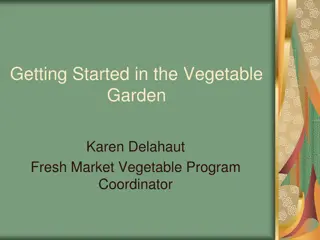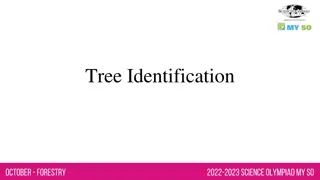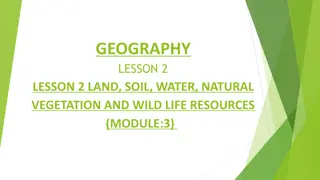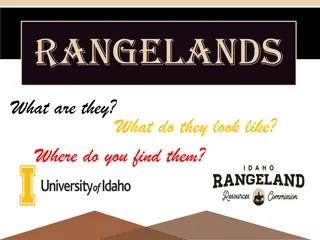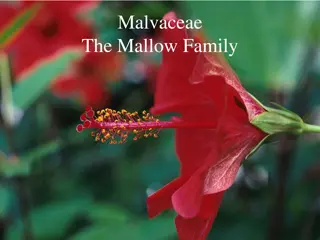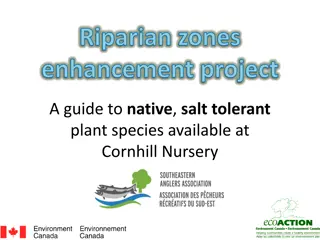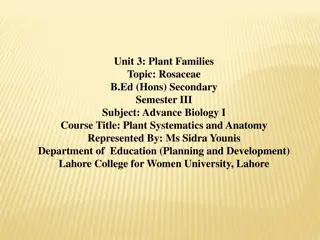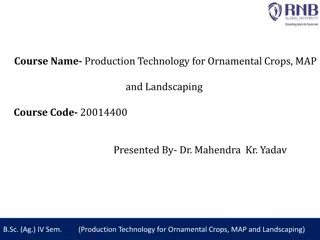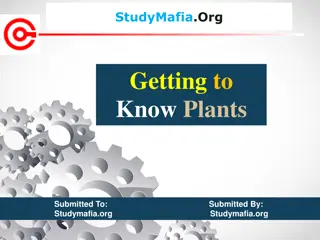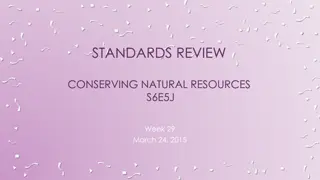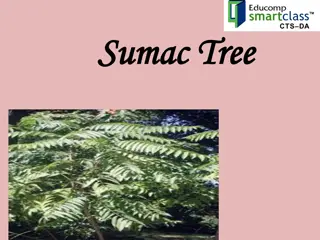Essential Tips for Starting Your Vegetable Garden
Get valuable insights on site selection, soil preparation, air drainage, proximity to trees and shrubs, weed control, and the physical requirements such as day length, soil quality, and nutrient content for a successful vegetable garden. Learn how to optimize your garden's location, soil health, sun
0 views • 39 slides
Understanding Trees: Identification, Characteristics, and Types
Explore the world of trees through tree identification, forest ecosystems, dendrology, and the distinguishing features of trees and shrubs. Learn about conifers vs. deciduous trees, the defining attributes of conifers, examples of conifer species, and the characteristics of conifer leaves and needle
0 views • 32 slides
Principles of Landscape Gardening and Landscaping Techniques
This course on production technology for ornamental crops, MAP, and landscaping covers the identification of ornamental and medicinal crops, principles of landscaping, uses of landscape trees, shrubs, and climbers, production technology of important ornamental crops, and more. It emphasizes the impo
0 views • 14 slides
Understanding Natural Vegetation and Wildlife Resources
Natural vegetation and wildlife play a crucial role in the biosphere, providing essential resources and maintaining ecological balance. The interaction between the lithosphere, hydrosphere, and atmosphere creates the biosphere where living organisms thrive. Plants offer timber, oxygen, and other val
0 views • 16 slides
Understanding Rangelands: An Overview of Natural Landscapes
Rangelands are uncultivated lands dominated by native plants such as grasses, forbs, and shrubs. They encompass areas not used for farming, dense forests, barren deserts, or solid rock. Rangelands support diverse ecosystems and are essential for various wildlife habitats and grazing animals.
0 views • 13 slides
Exploring the Malvaceae Family: Characteristics, Recognition, and Economic Importance
The Malvaceae family, also known as the Mallow family, consists of herbs and shrubs with distinct traits like alternate leaves, stellate hairs, radially symmetrical flowers with separate petals, and monadelphous stamens. With a worldwide distribution and diverse species, this plant family holds econ
0 views • 12 slides
Enhancing Riparian Zones: A Guide to Native Salt-Tolerant Plants at Cornhill Nursery
This guide provides information on various native salt-tolerant plant species available at Cornhill Nursery for enhancing riparian zones. It includes details on roses, fruiting shrubs like elderberry and red raspberries, shrubs such as witch hazel and wild raisin, deciduous trees like paper birch an
0 views • 15 slides
Exploring the Diverse World of Rosaceae Plant Family
Rosaceae, known as the rose family, is a significant family of flowering plants with a wide distribution, encompassing various herbs, shrubs, and trees. This family, with its 4,828 known species in 91 genera, plays a crucial role in ecosystems and economies worldwide. The Rosaceae family offers a va
0 views • 10 slides
Production Technology for Ornamental Crops, MAP and Landscaping Overview
This course covers the production technology for ornamental crops, MAP, and landscaping, presented by Dr. Mahendra Kr. Yadav. It includes identifying different types of ornamental and medicinal crops, principles of landscaping, uses of landscape trees, shrubs, and climbers, production technology of
0 views • 9 slides
Exploring the World of Plants: An Overview
Plants play a vital role in sustaining life on Earth by producing food and oxygen. This comprehensive guide delves into the diverse types of plants, such as herbs, shrubs, trees, creepers, and climbers. It also discusses the essential components of plants, like leaves, transpiration, and photosynthe
0 views • 20 slides
Standards Review: Conserving Natural Resources Activities
Explore activities and tips related to conserving natural resources, including using wind energy, preventing soil erosion, conserving water at home, and reducing pollution. Test your knowledge on conservation efforts with engaging questions and scenarios. Learn ways to save natural resources through
0 views • 9 slides
Agronomical Practices for Fodder Production - Part 1
Forage crops, fodder crops, and the characteristics of fodder crops are discussed in this informative content. It covers the classification of fodder into different types such as non-leguminous fodders, legumes, pasture grasses and legumes, fodder trees and shrubs, root crops, and miscellaneous fodd
0 views • 16 slides
Turkish Firms Showcase in Belgrad: A Glimpse of Dynamic Businesses
Explore a diverse range of Turkish firms featured in Belgrad, including Arokarya Plants specializing in high-quality trees and shrubs, Fresh Milk Production Farm from Foça known for its Holstein cows, and Demir Madençilik engaging in sectors like mining and agriculture. Discover Yunus Aydoğan's i
0 views • 17 slides
All About Sumac Trees: Features, Uses, and Care Tips
Sumac trees, known for their shrubs and small trees with clusters of reddish drupes, are commonly found in North America and Africa. These trees, comprising approximately 250 species, are used for landscaping but some species can cause skin irritation. With minimal care requirements, sumac trees can
0 views • 11 slides
